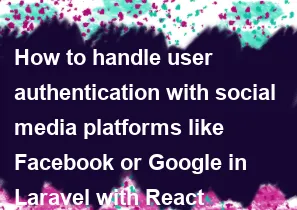How to handle user authentication with social media platforms like Facebook or Google in Laravel with React frontend

Handling user authentication with social media platforms like Facebook or Google in a Laravel backend with a React frontend involves a multi-step process. Below is a general guide on how you can achieve this. Keep in mind that the specific details may vary based on the Laravel and React versions you are using.
Laravel Backend:
Install Socialite: Laravel Socialite is a package that makes it easy to authenticate with OAuth providers. Install it using Composer:
bashcomposer require laravel/socialiteConfigure Services: In your
config/services.phpfile, add the credentials for Facebook and Google:php'facebook' => [ 'client_id' => env('FACEBOOK_CLIENT_ID'), 'client_secret' => env('FACEBOOK_CLIENT_SECRET'), 'redirect' => env('FACEBOOK_REDIRECT'), ], 'google' => [ 'client_id' => env('GOOGLE_CLIENT_ID'), 'client_secret' => env('GOOGLE_CLIENT_SECRET'), 'redirect' => env('GOOGLE_REDIRECT'), ],Environment Variables: Set the corresponding environment variables in your
.envfile:envFACEBOOK_CLIENT_ID=your-facebook-client-id FACEBOOK_CLIENT_SECRET=your-facebook-client-secret FACEBOOK_REDIRECT=http://your-app-url/login/facebook/callback GOOGLE_CLIENT_ID=your-google-client-id GOOGLE_CLIENT_SECRET=your-google-client-secret GOOGLE_REDIRECT=http://your-app-url/login/google/callbackRoutes: Define routes for handling the OAuth callbacks in
routes/web.php:phpRoute::get('/login/facebook', 'Auth\LoginController@redirectToFacebook'); Route::get('/login/facebook/callback', 'Auth\LoginController@handleFacebookCallback'); Route::get('/login/google', 'Auth\LoginController@redirectToGoogle'); Route::get('/login/google/callback', 'Auth\LoginController@handleGoogleCallback');Controller Methods: In your
Auth\LoginControlleror a similar controller, create methods to redirect to social media login and handle the callback:phpuse Laravel\Socialite\Facades\Socialite; public function redirectToFacebook() { return Socialite::driver('facebook')->redirect(); } public function handleFacebookCallback() { $user = Socialite::driver('facebook')->user(); // Your logic to authenticate or create a user // Redirect or return a response } public function redirectToGoogle() { return Socialite::driver('google')->redirect(); } public function handleGoogleCallback() { $user = Socialite::driver('google')->user(); // Your logic to authenticate or create a user // Redirect or return a response }
React Frontend:
Implement Frontend UI: Create a login button or UI elements for users to initiate the social media login process. You can use libraries like
react-facebook-loginandreact-google-login.Make API Requests: Use Axios or another HTTP library to make requests to your Laravel backend for initiating and handling social media authentication.
Handle Responses: Handle the responses from your backend API. If the authentication is successful, you may want to store the user's session/token or perform other actions based on your application's requirements.
This is a high-level overview, and you may need to customize it based on your specific project requirements. Additionally, consider implementing security measures, such as validating and sanitizing user input, protecting against CSRF attacks, and ensuring secure storage of user information.
-
Popular Post
- How to optimize for Google's About This Result feature for local businesses
- How to implement multi-language support in an Express.js application
- How to handle and optimize for changes in mobile search behavior
- How to handle CORS in a Node.js application
- How to use Vue.js with a UI framework (e.g., Vuetify, Element UI)
- How to configure Laravel Telescope for monitoring and profiling API requests
- How to create a command-line tool using the Commander.js library in Node.js
- How to implement code splitting in a React.js application
- How to use the AWS SDK for Node.js to interact with various AWS services
- How to use the Node.js Stream API for efficient data processing
- How to implement a cookie parser middleware in Node.js
- How to implement WebSockets for real-time communication in React
-
Latest Post
- How to implement a dynamic form with dynamic field styling based on user input in Next.js
- How to create a custom hook for handling user interactions with the browser's device motion in Next.js
- How to create a custom hook for handling user interactions with the browser's battery status in Next.js
- How to implement a dynamic form with dynamic field visibility based on user input in Next.js
- How to implement a dynamic form with real-time collaboration features in Next.js
- How to create a custom hook for handling user interactions with the browser's media devices in Next.js
- How to use the useSWRInfinite hook for paginating data with a custom loading indicator in Next.js
- How to create a custom hook for handling user interactions with the browser's network status in Next.js
- How to create a custom hook for handling user interactions with the browser's location in Next.js
- How to implement a dynamic form with multi-language support in Next.js
- How to create a custom hook for handling user interactions with the browser's ambient light sensor in Next.js
- How to use the useHover hook for creating interactive image zoom effects in Next.js